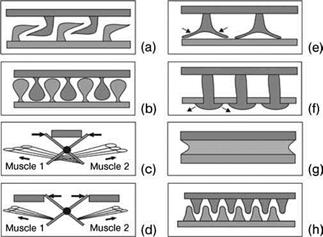8.16.1
Design Principles of Biological Attachment Devices
In Nature, attachment devices serve as functional systems, the purpose of which is either temporary or permanent mechanical attachment of an organism to a substrate surface, to another organism, or the temporary interconnection of body parts within an organism. Many species of animals and plants are supplied with diverse attachment devices, and there is no doubt that many functional solutions have evolved independently in different lineages. The morphology depends on the species biology and the particular function in which the attachment is involved. The evolutionary background and the habits influence the specific composition of attachment systems in each particular species [84].
There are eight fundamental classes of attachment principles (Figure 8.81): (1) hooks; (2) lock or snap; (3) clamp; (4) spacer; (5) suction; (6) expansion anchor;
|
Figure 8.81 Fundamental principles of attachment found in Nature. (a) hooks; (b) lock or snap; (c) clamp; (d) spacer; (e) suction; (f) expansion anchor; (g) adhesive secretions (glue); (h) friction. |
(7) adhesive secretions (glue); and (8) friction. However, different combinations of these principles also occur.
Adhesion developed by biological adhesives can be due to the use of different basic physical forces, with the adhesive effect often being enhanced by particular contact geometry and mechanical interlocking between the adhesive and irregularities of the contact surface.
8.16.2
 15 января, 2016
15 января, 2016  Pokraskin
Pokraskin 
 Опубликовано в рубрике
Опубликовано в рубрике 